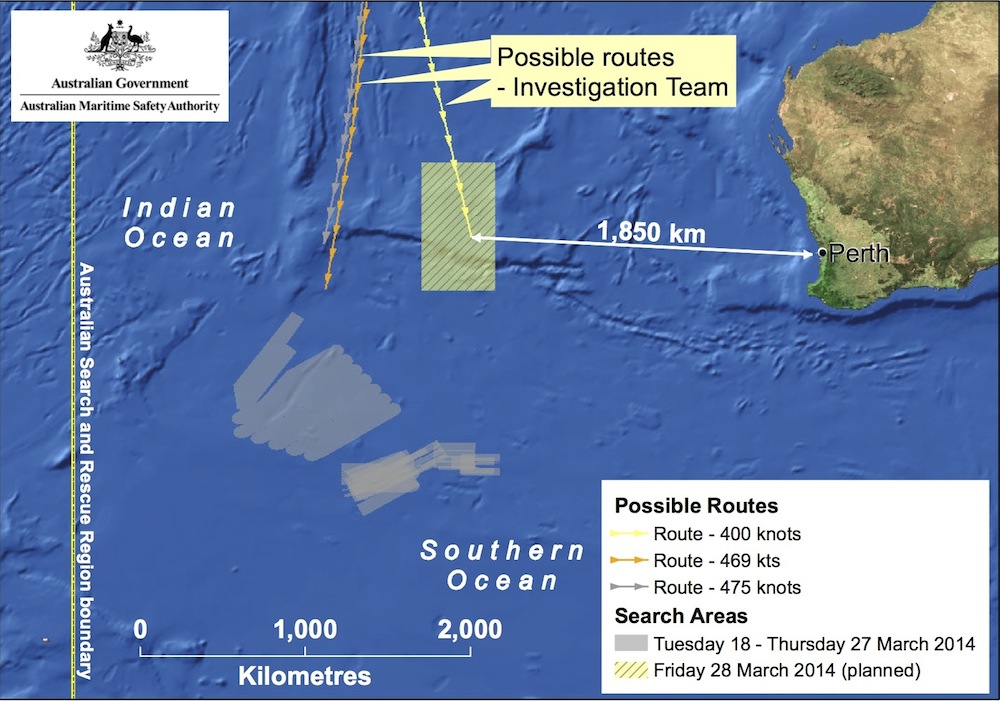'Credible Lead' Shifts Search for Missing Malaysian Plane 700 Miles North

Searchers on patrol planes detected several objects — possibly from the missing Malaysian jetliner — floating in the Indian Ocean today (March 28), after search efforts were shifted nearly 700 miles (1,130 kilometers) to the northeast following the "latest credible lead," according to officials from the Australian Maritime Safety Authority (AMSA).
Five search planes detected "multiple objects of various colors" within the new search area, which is located about 1,150 miles (1,850 kilometers) west of the Australian city of Perth, reported ABC News.
Photographs of the debris will be analyzed overnight, but AMSA officials said they will not be able to determine any possible link between the objects and the lost Malaysian Airlines Flight MH370 until the pieces are relocated and recovered by patrol ships. [Facts & Timeline About Malaysia Flight 370]
Ten planes searched a total of 98,840 square miles (256,000 square kilometers) today, all falling within the new search zone, according to AMSA. Operations will resume tomorrow, AMSA officials said, and weather conditions in the region are expected to cooperate.
Search officials have been unable to locate hundreds of floating objects that were spotted further south earlier this week by French and Thai satellites, leaving investigators unsure if these objects are related to the plane at all.
"Because of ocean drift, this new search area could still be consistent with the potential objects identified by various satellite images over the past week," Malaysia's Acting Transport Minister Hishammuddin Hussein said, according to ABC News. "With each step, we get closer to understanding MH370's flight path."
After weeks of focusing on a swath of the southern Indian Ocean, the search area was shifted northeast after new studies indicated the plane was likely traveling faster and thus burning more fuel than previously thought. This means the Malaysian Airlines jet may have run out of fuel and crashed sooner than early estimates projected.
Get the world’s most fascinating discoveries delivered straight to your inbox.
"This actually happens to us all the time," AMSA General Director John Young said of the change, according to ABC News. "New information will emerge out of sequence with the investigation itself."
The international search, led by AMSA, includes planes and ships from the United States, Australia, New Zealand, Japan, China and South Korea.
The Malaysian Airlines jetliner has been missing since March 8, when it mysteriously disappeared during a scheduled flight from Kuala Lumpur to Beijing. Ongoing investigations conclude that the plane's last known position was in the middle of the Indian Ocean, but the precise whereabouts of the aircraft and the 239 people onboard, remain unknown.
Follow Denise Chow on Twitter @denisechow. Follow Live Science @livescience, Facebook & Google+. Original article on Live Science.

Denise Chow was the assistant managing editor at Live Science before moving to NBC News as a science reporter, where she focuses on general science and climate change. Before joining the Live Science team in 2013, she spent two years as a staff writer for Space.com, writing about rocket launches and covering NASA's final three space shuttle missions. A Canadian transplant, Denise has a bachelor's degree from the University of Toronto, and a master's degree in journalism from New York University.


